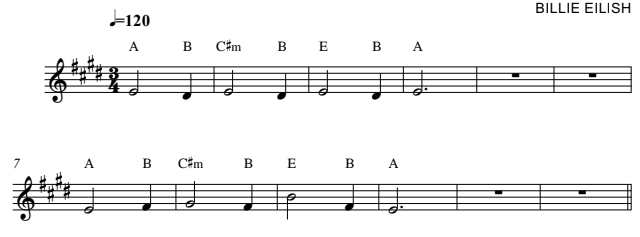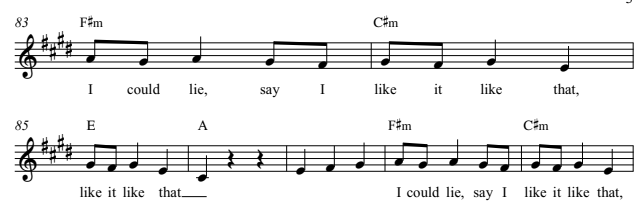<< Download the FREE lead sheet here >>
Billie Eilish has said this song represents needing space from someone, telling them, “I’ll call you when the party’s over”.
It was written by her brother Finneas O’Connell and we’ll be learning it in its original key of E major. That means FOUR sharps.
But the chords are pretty basic and don’t change too much.
This is the key to the whole song, so it’s important you spend a bit of time making sure you’re comfortable with this chord progression. It’s used in the introduction and all the verses:

These are not complicated chords to play on their own, but it could take some practice to move in between them quickly and smoothly. You can choose to play them all in root position, but I find using inversions makes it much easier to play.
I won’t go into inversions here, because we have a complete lesson on them which you can find here.
Don’t rush through this. I can’t stress enough how important it is that you spend some time on this progression. It makes the rest of the song SO. MUCH. EASIER.
While you’re playing chords in your right hand, the left hand can either play single notes, octaves or fifths. Personally, I prefer fifths for this, but you can choose whichever you like.
The good thing is that once you can play this part easily, you can play 80% of the song. There are only two more sections to learn…
The start of the chorus is very similar to the verses we’ve just been playing, but there is a new chord that we haven’t seen so far:

It’s that sneaky little F#m. That means it’s an F# minor chord, so the notes are F#-A-C#. But other than that the chords are all ones you should be able to play easily (if you practiced the intro as I said).
You can choose to play the F#m in root position, but I like playing it 2nd inversion, which means the order of the notes is C#-F#-A.
And that’s the chorus. There’s one more part of the song to learn, and on paper, it looks like the hardest part. But when we break it down you’ll see that it’s a lot easier to play than it looks.
We’ll spend a little bit of time on the bridge because there are some chords here that might strike fear into your heart. But they shouldn’t! If you’ve made it this far, you can totally do it 🙂
We enter the bridge with a passing chord, and it’s also a slash chord. It’s this freaky C#m/G#. It appears in the intro to the bridge and the second line:

You can learn more about slash chords here. But all this means is you play a C#m chord with your right hand (which you have been doing all along) and instead of playing C# in your left hand, you play G#.
The next line is where things get funky. Take a look at these chords and see if you can figure out what they mean:

You might have seen the first one before. It’s a dominant 7th chord. For a B7 chord, that just means playing a B triad (like earlier in the song) and adding a flattened 7th note, which in this case is an A.
For more on dominant 7th chords (and other 7th chords), check out this lesson.
The second tricky chord you may have never seen before. First of all, it’s an A# chord (yuck!) and it’s got that little circle next to it. That circle means it’s a diminished chord. A diminished chord is made up of a stack of minor third intervals.
So let’s break it down. Our root note is an A#. A minor third above A# is C#. So that’s our second note. Now, what’s a minor 3rd above C#? E!
So the notes of the A#o (A-sharp diminished) chord are A# – C# – E.
Here’s where things get easy. Take a look at the chord BEFORE that A#o chord. It’s an A major chord. And what are the notes of an A major chord?
A – C# – E.
So you can see how changing from that A chord to the A#o chord only means CHANGING ONE SINGLE NOTE. Nothing else.
Suddenly something that looked so scary isn’t scary anymore. I find this can be true for a lot of music notation. It often looks super complicated and advanced, but if we stop and take a step back, it’s not as hard as we thought.
And that, my friends, is how to play “When the Party’s Over”!
I would LOVE to see your covers of this song. So if you do, make sure you comment below with a link to the video — or you can tag us on Instagram @pianoteofficial.
Good luck and have fun! I can’t wait to see what you come up with.
Lisa Witt has been teaching piano for more than 20 years and in that time has helped hundreds of students learn to play the songs they love. Lisa received classical piano training through the Royal Conservatory of Music, but she has since embraced popular music and playing by ear in order to accompany herself and others. Learn more about Lisa.
/marketing/pianote/promos/april/banner-bg-m.webp)
We use cookies for traffic data and advertising. Cookie Policy »
/marketing/pianote/promos/april/banner-title.webp)